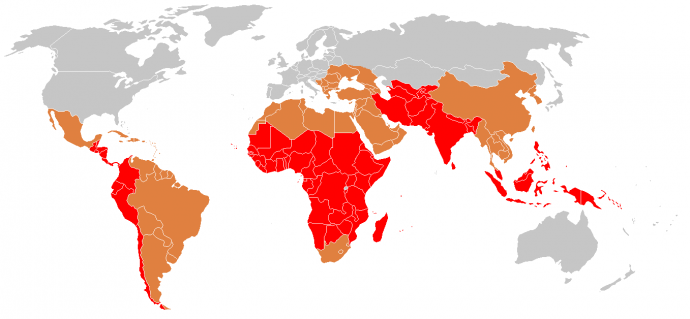If you’re traveling internationally in anything resembling a developing country, you should probably get vaccinated for typhoid fever. It’s simple to do, and it’s inexpensive as well.
According to Passport Health, typhoid fever affects over 21 million people annually, causing over 200,000 deaths per year – largely in areas that lack proper sanitation and water systems. Symptoms include fever, anorexia, abdominal discomfort and headaches.
For which countries does one need a typhoid immunization? The CDC website knows:
“Typhoid fever is common in most parts of the world except in industrialized regions such as the United States, Canada, western Europe, Australia, and Japan. Therefore, if you are traveling to the developing world, you should consider taking precautions. Over the past 10 years, travelers from the United States to Asia, Africa, and Latin America have been especially at risk.”
How does one acquire typhoid fever?
Travelers generally become infected with typhoid fever from the food or drink they consume.
To best protect one’s self from typhoid fever in the day-to-day of international travel, abide by the following rules:
- Avoid tap water, and avoid ice in your drinks – unless you can confirm that it’s made from purified bottled water.
- Eat foods that have been thoroughly cooked (as in, not raw), and avoid raw fruits and vegetables that cannot be peeled. Examples of things that cannot be peeled: lettuce, grapes. Things that can be peeled: apples, oranges, potatoes, etc.
- And the hardest one for me: the Centers for Disease Control (CDC) website recommends that travelers AVOID STREET FOOD, as sanitation, handling and refrigeration methods aren’t as (potentially) stringent on the street as they are in a brick-and-mortar restaurant. Food prep methods may be equally unsavory at your all-inclusive resort or cruise ship (especially those!) though, so don’t count on avoidance of street food as a magic bullet against potential food-borne illness.
- Wash your hands before preparing foods and/or eating them.
There are two methods by which one can be immunized against typhoid:
- BOOSTER SHOT (injection): One-time shot in the arm at your local travel medicine clinic. Lasts for two years. US $90.00.
- CAPSULES: Four pills to take over the course of seven days, with a few caveats (see below). Lasts five years. US $80.00.
Who should get the shot? Who should take the pills?
If you’re planning a one-time international trip, just get the shot and be done with it. It’s easier.
If you’re a repeat traveler (or I guess if you’re terrified of needles), you might want to take the pills to extend your period of immunization to five years (and to save a whopping US $10). Here’s what taking the pills (specific type I took: VIVOTIF TYPHOID VACCINE LIVE ORAL Ty21a) will require of you:
- You’ll receive four pills, which must be taken orally every other day, at least 1-2 weeks prior to travel to ensure immunization. I picked mine up from my local Visiting Nurse Assocation, but any travel health clinic will do.
- The pills have to be refrigerated at all times, between temperatures of 35.6-46.4 F (2-8 C).
- Capsules must be taken one hour before eating or two hours after eating, with a full glass of water
- After taking a capsule, one must wait at least two hours before eating or drinking any milk, protein or alcohol products.
- Don’t take your typhoid capsules with oral antibiotics.
The rules of the pills aren’t terribly stringent, but they will make you think a little – especially if you’re don’t regularly take medication, or if you’re a busy person with an erratic schedule. I found my week of pills to be a bit tricky, but doable of course.
RELATED POST: Travel Health: Immunizations, Diarrhea & Malaria







